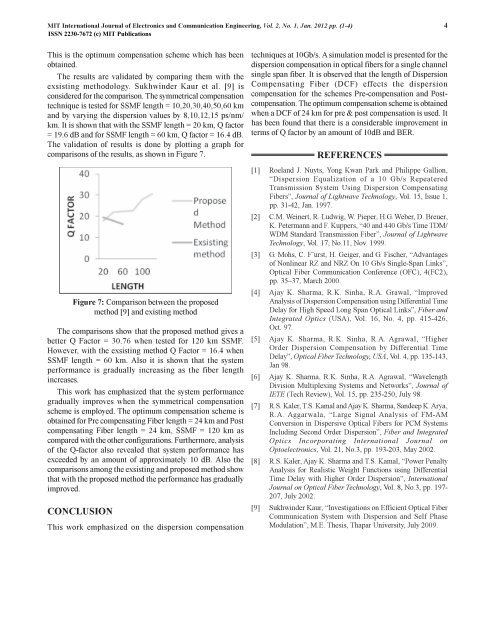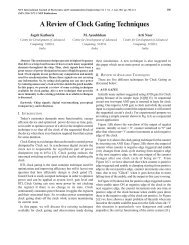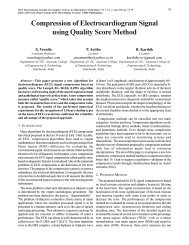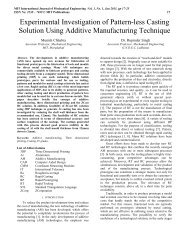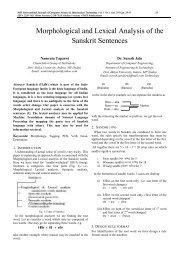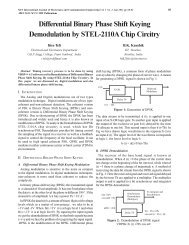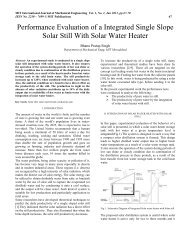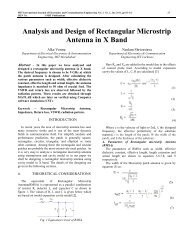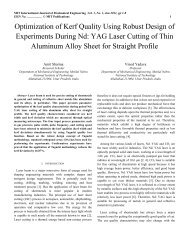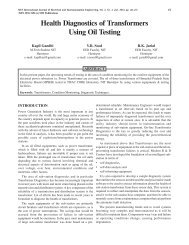Dispersion Compensation for High Speed Optical ... - MIT Publications
Dispersion Compensation for High Speed Optical ... - MIT Publications
Dispersion Compensation for High Speed Optical ... - MIT Publications
You also want an ePaper? Increase the reach of your titles
YUMPU automatically turns print PDFs into web optimized ePapers that Google loves.
<strong>MIT</strong> International Journal of Electronics and Communication Engineering, Vol. 2, No. 1, Jan. 2012 pp. (1-4) 4ISSN 2230-7672 (c) <strong>MIT</strong> <strong>Publications</strong>This is the optimum compensation scheme which has beenobtained.The results are validated by comparing them with theexsisting methodology. Sukhwinder Kaur et al. [9] isconsidered <strong>for</strong> the comparison. The symmetrical compensationtechnique is tested <strong>for</strong> SSMF length = 10,20,30,40,50,60 kmand by varying the dispersion values by 8,10,12,15 ps/nm/km. It is shown that with the SSMF length = 20 km, Q factor= 19.6 dB and <strong>for</strong> SSMF length = 60 km, Q factor = 16.4 dB.The validation of results is done by plotting a graph <strong>for</strong>comparisons of the results, as shown in Figure 7.Figure 7: Comparison between the proposedmethod [9] and existing methodThe comparisons show that the proposed method gives abetter Q Factor = 30.76 when tested <strong>for</strong> 120 km SSMF.However, with the exsisting method Q Factor = 16.4 whenSSMF length = 60 km. Also it is shown that the systemper<strong>for</strong>mance is gradually increasing as the fiber lengthincreases.This work has emphasized that the system per<strong>for</strong>mancegradually improves when the symmetrical compensationscheme is employed. The optimum compensation scheme isobtained <strong>for</strong> Pre compensating Fiber length = 24 km and Postcompensating Fiber length = 24 km, SSMF = 120 km ascompared with the other configurations. Furthermore, analysisof the Q-factor also revealed that system per<strong>for</strong>mance hasexceeded by an amount of approximately 10 dB. Also thecomparisons among the exsisting and proposed method showthat with the proposed method the per<strong>for</strong>mance has graduallyimproved.CONCLUSIONThis work emphasized on the dispersion compensationtechniques at 10Gb/s. A simulation model is presented <strong>for</strong> thedispersion compensation in optical fibers <strong>for</strong> a single channelsingle span fiber. It is observed that the length of <strong>Dispersion</strong>Compensating Fiber (DCF) effects the dispersioncompensation <strong>for</strong> the schemes Pre-compensation and Postcompensation.The optimum compensation scheme is obtainedwhen a DCF of 24 km <strong>for</strong> pre & post compensation is used. Ithas been found that there is a considerable improvement interms of Q factor by an amount of 10dB and BER.REFERENCES[1] Roeland J. Nuyts, Yong Kwan Park and Philippe Gallion,“<strong>Dispersion</strong> Equalization of a 10 Gb/s RepeateredTransmission System Using <strong>Dispersion</strong> CompensatingFibers”, Journal of Lightwave Technology, Vol. 15, Issue 1,pp. 31-42, Jan. 1997.[2] C.M. Weinert, R. Ludwig, W. Pieper, H.G. Weber, D. Breuer,K. Petermann and F. Kuppers, “40 and 440 Gb/s Time TDM/WDM Standard Transmission Fiber”, Journal of LightwaveTechnology, Vol. 17, No.11, Nov. 1999.[3] G. Mohs, C. F¨urst, H. Geiger, and G. Fischer, “Advantagesof Nonlinear RZ and NRZ On 10 Gb/s Single-Span Links”,<strong>Optical</strong> Fiber Communication Conference (OFC), 4(FC2),pp. 35–37, March 2000.[4] Ajay K. Sharma, R.K. Sinha, R.A. Grawal, “ImprovedAnalysis of <strong>Dispersion</strong> <strong>Compensation</strong> using Differential TimeDelay <strong>for</strong> <strong>High</strong> <strong>Speed</strong> Long Span <strong>Optical</strong> Links”, Fiber andIntegrated Optics (USA), Vol. 16, No. 4, pp. 415-426,Oct. 97.[5] Ajay K. Sharma, R.K. Sinha, R.A. Agrawal, “<strong>High</strong>erOrder <strong>Dispersion</strong> <strong>Compensation</strong> by Differential TimeDelay”, <strong>Optical</strong> Fiber Technology, USA, Vol. 4, pp. 135-143,Jan 98.[6] Ajay K. Sharma, R.K. Sinha, R.A. Agrawal, “WavelengthDivision Multiplexing Systems and Networks”, Journal ofIETE (Tech Review), Vol. 15, pp. 235-250, July 98.[7] R.S. Kaler, T.S. Kamal and Ajay K. Sharma, Sandeep K. Arya,R.A. Aggarwala, “Large Signal Analysis of FM-AMConversion in Dispersive <strong>Optical</strong> Fibers <strong>for</strong> PCM SystemsIncluding Second Order <strong>Dispersion</strong>”, Fiber and IntegratedOptics Incorporating International Journal onOptoelectronics, Vol. 21, No.3, pp. 193-203, May 2002.[8] R.S. Kaler, Ajay K. Sharma and T.S. Kamal, “Power PenaltyAnalysis <strong>for</strong> Realistic Weight Functions using DifferentialTime Delay with <strong>High</strong>er Order <strong>Dispersion</strong>”, InternationalJournal on <strong>Optical</strong> Fiber Technology, Vol. 8, No.3, pp. 197-207, July 2002.[9] Sukhwinder Kaur, “Investigations on Efficient <strong>Optical</strong> FiberCommunication System with <strong>Dispersion</strong> and Self PhaseModulation”, M.E. Thesis, Thapar University, July 2009.


